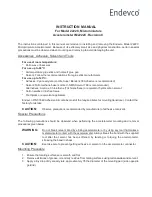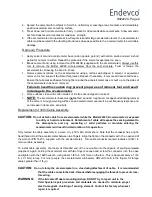
®
IM2222C, Page 2
4. Spread the cement with toothpick to form thin, uniform layer covering area of contact, and immediately
position accelerometer on mating surface.
5. Press down and hold accelerometer firmly in place for 30 seconds while cement sets. Allow cement to
set for at least several minutes for maximum strength.
6. If the accelerometer is to operate at low frequencies and/or large acceleration levels, the accelerometer
cable must be secured to the vibrating structure as close as possible to the accelerometer to avoid cable
damage.
Removal Procedure
1.
Apply solvent around accelerometer base (side opposite gold lid) with cotton swab and wait a short
period for cement to soften. Repeat the procedure if the solvent evaporates too soon.
2.
Break cement bond, using removal tool P/N 2943B (supplied with the accelerometer). Always use this
tool to remove the Model 2222C Accelerometer from the test structure. Twist or torque the
accelerometer, stressing the bond in shear.
3.
Remove cement residue on the accelerometer using a cotton swab dipped in solvent or equivalent
remover. A short soak will facilitate this process. Repeat, if necessary, to remove all traces of adhesive.
Ensure that all excess adhesive forming fillet around the accelerometer case or built up on the sides of
the accelerometer has been removed.
Failure to heed this caution may prevent proper use of removal tool and result
in damage to the accelerometer
.
4.
Wipe surfaces clean with cotton swabs or lint-free tissue dipped in solvent.
5.
NOTE:
The accelerometer base must
not
be filed, sanded, roughened, or edges burred during removal
of the cement. A rough mounting surface on an accelerometer can result in poor frequency response and
an increase in transverse sensitivity.
Replacement of 3093 Cable Assembly
CAUTION:
Do not detach cable from accelerometer while the Model 2222C Accelerometer is exposed
to a dirty or humid environment. Detachment of cable will expose the sensing element to
the atmosphere, and any conducting or solid particles or moisture entering the
accelerometer will result in deterioration of its operation.
Only remove the cable assembly in a clean, dry (<50% RH) atmosphere. Note that the connector has a right-
hand thread. Hold the accelerometer between two fingers. Align the flats on the connector with the open end of
the wrench (P/N 16205, supplied with the accelerometer). Turn cable connector counter clockwise (CCW) to
remove cable assembly.
To install cable assembly, dip the small threaded end of the new cable into the capsule of sealing compound
(supplied). Again, holding the accelerometer with two fingers on one hand, screw the connector into the case
and tighten with the 16205 wrench, using about 1-lbf (~4.5 N) force on the tool. This is approximately a 1 lbf-
in (~0.1 Nm) torque. For most people, the accelerometer will become difficult to hold in the fingers for torque
values greater than 1 lbf-in.
CAUTION:
Do not clamp the accelerometer in a vise during attachment of cable. It is recommended
that the cable connector be back-threaded before engaging the threads to prevent cross-
threading.
WARNING:
If the lid came off due to mounting mishap, DO NOT try to repair unit in the
field. Special repair procedure and materials are needed to maintain proper
electro-magnetic shielding of sensing element. Contact the factory whenever
repair is required.




















